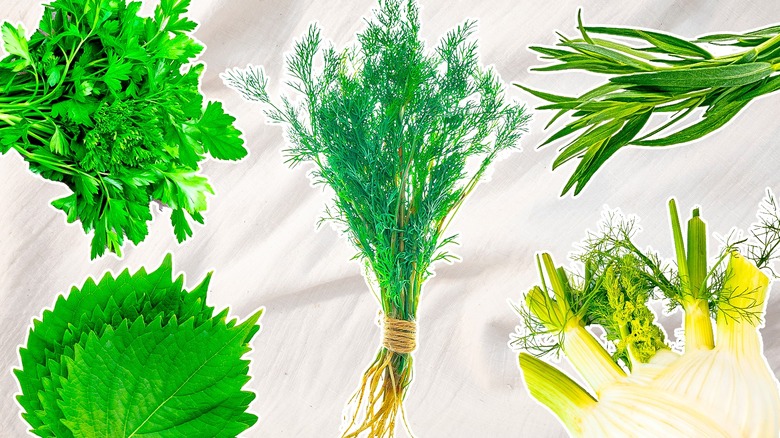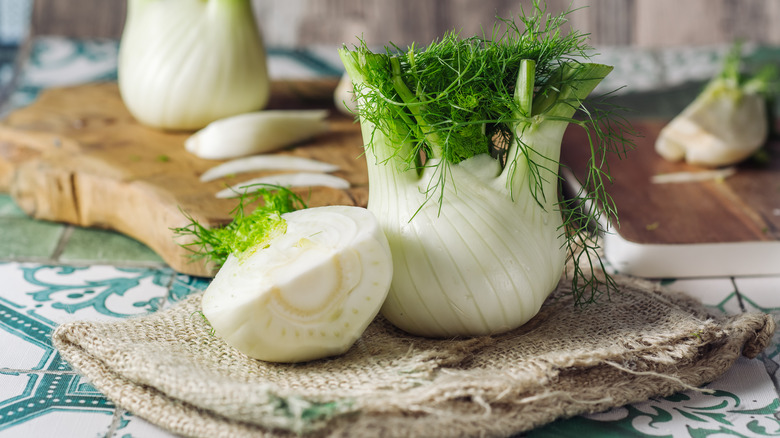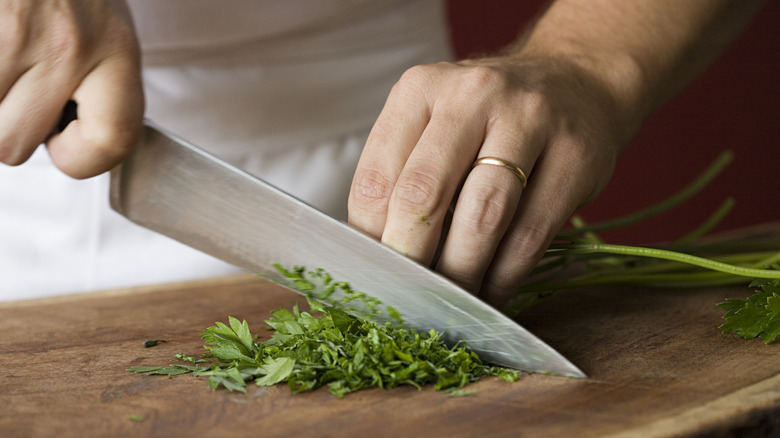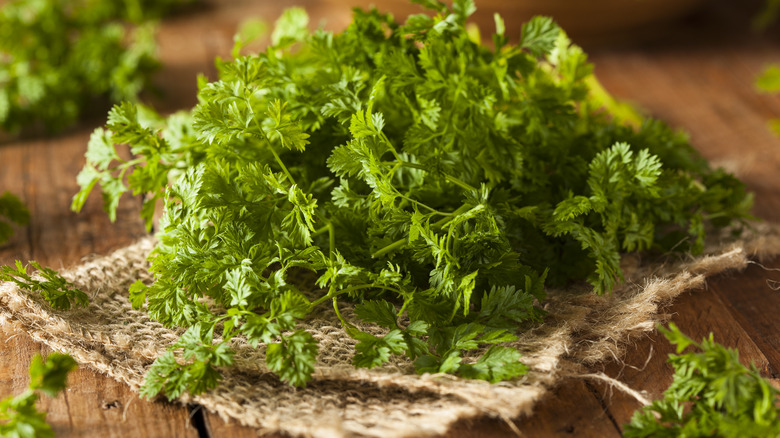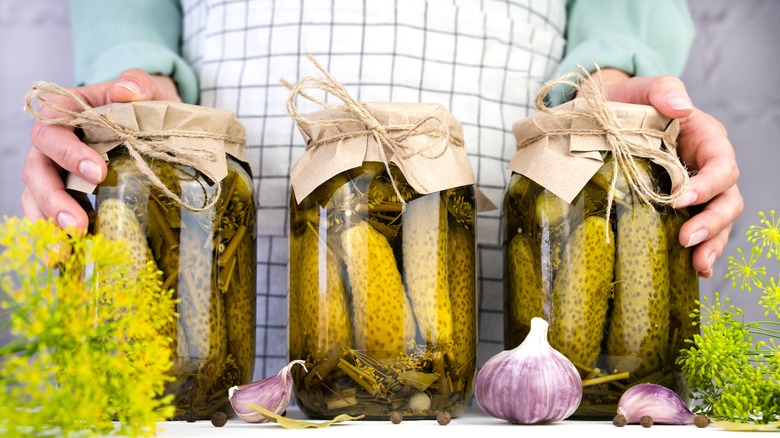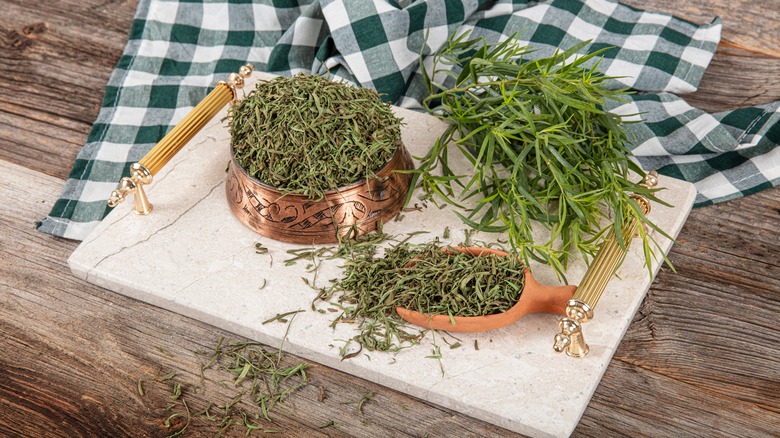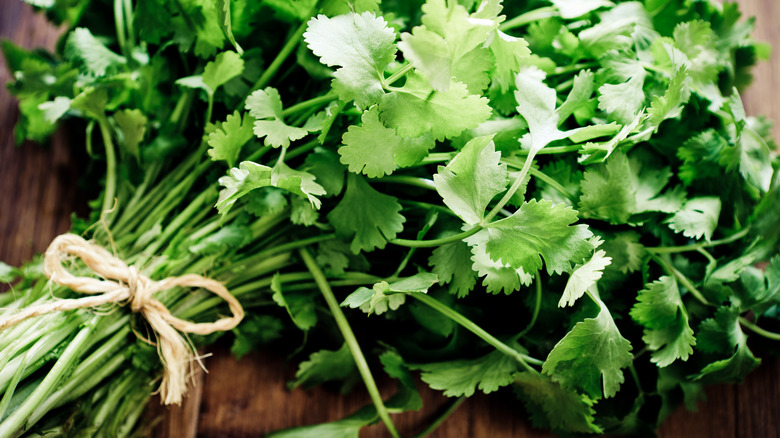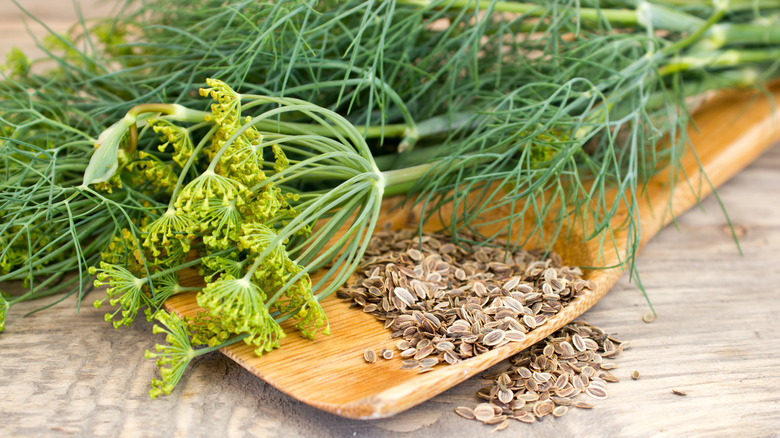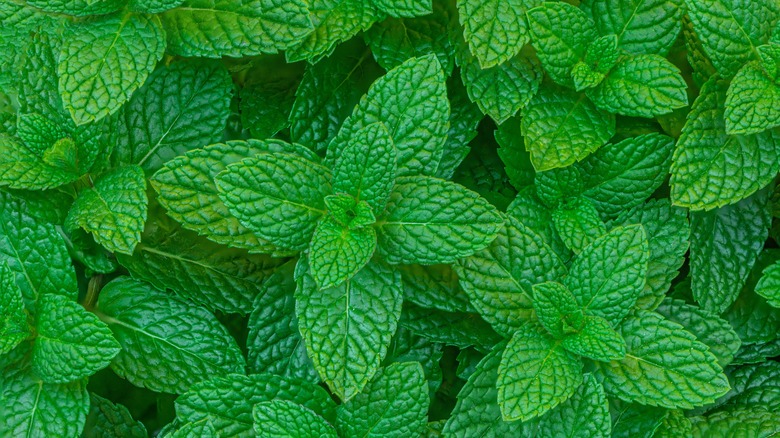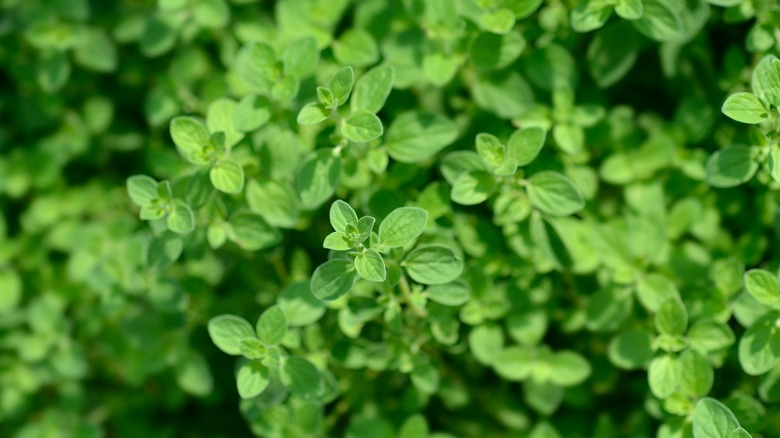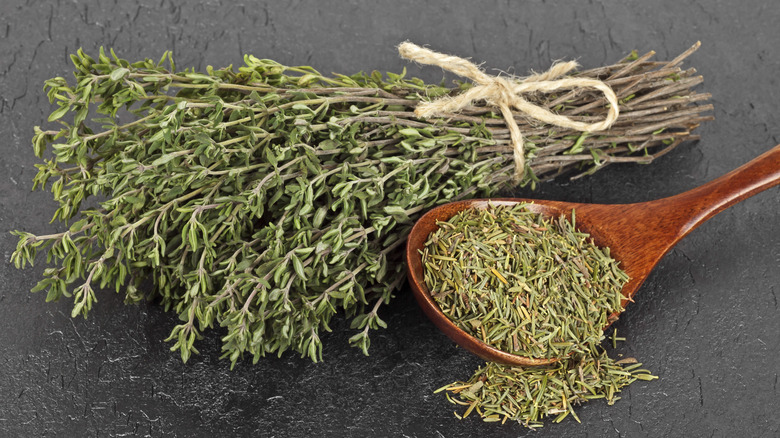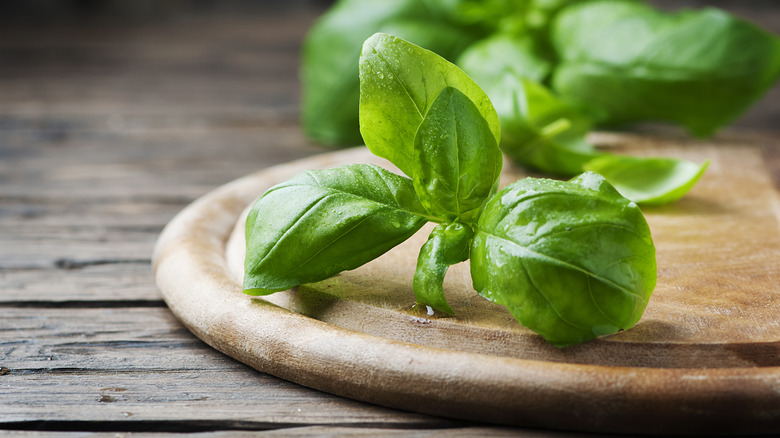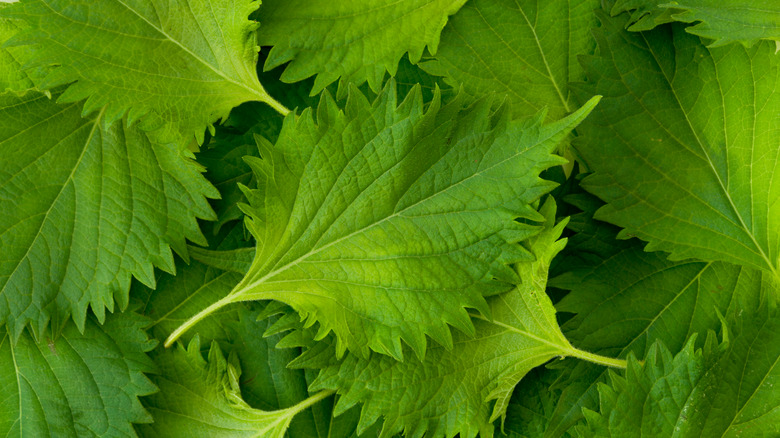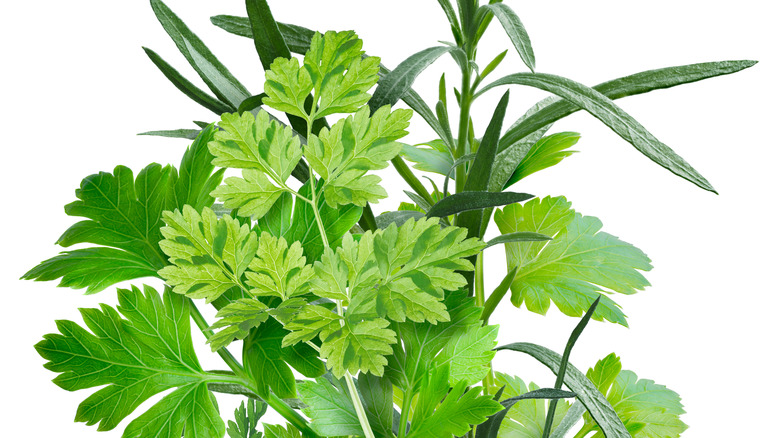13 Best Substitutes For Dill, According To A Chef
It's really hard to put flavors into words. That's why professional wine tasters have such a specialized vocabulary; it helps them communicate the taste of the wine in a way that others can understand. You don't need that kind of vocabulary to make substitutions with foods, but being able to put a finger on a few of the main flavors in a given ingredient certainly helps. In the case of dill, its distinctive taste contains lots of interesting notes worth articulating and understanding. The boldest is licorice or anise, but you'll also taste hints of citrus, florals, and green and grassy tones.
While no other herb tastes exactly like dill, several of them contain at least a few of these same flavor notes, or work in the same dishes dill normally graces. As a trained chef and former restaurateur (and an avid gardener), I have worked with a lot of herbs over the years. Now, I've drawn on that experience to compile a list of 13 substitutes for dill you can choose from as needed.
Fennel fronds
Fennel is both an aromatic vegetable and a herb. Its bulbous base is crisp and juicy, like a pudgy, licorice-y celery, and can be shaved raw for salads or cooked as a side dish. The delicate fronds that top its stems have the same flavor, and are used as both a flavoring and a garnish.
That anise-like flavor note is one thing that makes fennel a go-to substitute for dill, but the physical resemblance also helps. Using fennel as a substitute for dill means your finished dishes will look exactly like they're supposed to, because its fine fronds can easily be mistaken for dill at a glance.
Fennel fronds are also available in dried form, like dill (you can also easily dry it at home the next time you buy fresh fennel). Dill loses a lot of its subtle, elusive flavors when it's dried, becoming milder and more one-dimensional. The same thing happens with fennel, though, so in recipes that call for dried dill, dried fennel is as close to a perfect substitute as you'll find.
Parsley
Ah, parsley. Is there any other herb so widely used and so little loved? For many people it's the overlooked and undervalued member of the culinary herb family, Cinderella minus the fairy godmother, just a disregarded bit of greenery sitting lonely and purposeless at the side of the plate.
We chefs see it differently: Parsley is the quintessential supporting player. It doesn't have a dominant flavor of its own, just a fresh, green note with a subtle bitter earthiness. Yet it enhances the flavors of other foods around it, just as mushrooms and celery do.
Parsley captures that elusive grassy element so prominent in dill's flavor, and has the advantage of being readily available year-round. In dishes where dill plays a supporting role rather than the lead, parsley is an excellent substitute (especially if you're substituting because you don't really care for dill). On a pragmatic note, since it's sold in large bunches but used in small spoonfuls, it's also an herb you're likely to have on hand and need to use up. Parsley is a great team player and deserves more of your attention.
Chervil
It often takes a second glance to see the difference between cilantro and flat-leaf parsley — things get even more complicated with chervil is involved. Yet another herb characterized by many ruffled leaves, it's hard to find in North America unless you grow it yourself or live near a really good market. However, it's cherished in France. Chervil is a member of the same broad family that contains parsley, cilantro, and caraway, which explains the resemblance. It's more delicate than parsley, with finer, thinner leaves, and it has a mild anise flavor with green and peppery undertones, all of which overlap with the flavors of dill.
Chervil is often described as a more elegant and flavorful parsley substitute, but we find it works well with many of the foods that are commonly paired with dill: salmon, yogurt, potatoes, and eggs, to name just a few. In France it's one of the four "fines herbes" in that classic mixture, and — if you can get your hands on it, or grow it in your garden — it's well worth getting acquainted with in its own right.
Pickle juice or dill pickles
Sometimes, we overthink things to the point of missing obvious solutions. So it goes with substituting dill. If you don't have dill, why not turn to something that's already infused with bold dill flavor: the famous dill pickle?
There's a strong chance you have a jar of dill pickles in your refrigerator already. The pickles themselves can be used in some recipes, such as salad dressings or potato salad, in place of fresh dill. The brine from the jar of pickles is even more versatile, with garlic and mixed pickling spices adding a kick in support of the bold dill flavor. It's not suited to every dish, but when you can use it, you'll get an intense hit of pure dill that works excellently as a substitute.
Brush the brine onto salmon where you'd otherwise use a handful of chopped dill. Add a splash instead of the fresh herb when you're pulling together a potato salad. There are plenty of other recipes that use leftover pickle juice to mimic the classic herb, from tzatziki to dilled potatoes. Have fun experimenting!
Tarragon
Like chervil, tarragon is a cherished herb in Europe (especially France), but rarely used in North America. You'll sometimes see it referred to as "the little dragon" — its scientific name is Artemisia dracunculus, and that's literally what dracunculus means – because its leaves were fancifully thought to resemble a dragon's tongue. Tarragon has a distinct licorice flavor, with hints of pepper and mint. While it doesn't exactly taste like dill, it doesn't exactly not taste like dill, either. Its flavor most closely resembles anise, and is much more powerful than dill — you'll need to use a lot less if you're swapping it in. If you keep this mind, though, you'll find it works well in most of the same dishes.
Most foods that are typically paired with dill, including salmon, potatoes, cucumbers, and fresh green salads, go equally well with tarragon. A big difference is that tarragon has the oomph to stand up to bolder flavors, which is why tarragon-flavored Béarnaise sauce is often paired with steaks. You may not know how to use tarragon now, but test-driving it as a dill replacement is a good way to start.
Cilantro
Cilantro is a polarizing herb. For most of us, it has a uniquely fresh and pleasant flavor. But for a minority, eating it is like having one's mouth washed out with soap. If you're in that minority, you have our condolences — but for the rest of us, this is one useful herb. Cilantro looks much like parsley and chervil, and its dominant flavor notes are green and floral, with a citrusy undertone. These are similar to many of the flavors in dill, which means cilantro can be a surprisingly good dill substitute. It's not suited for every recipe, necessarily, but it works well in dishes like salads where the other ingredients downplay dill's anise note in favor of its bright, citrusy tones.
It's worth noting that recipes from some parts of the English-speaking world may refer to cilantro as fresh coriander or just coriander, while North American recipes usually mean the seed when they use these terms. We personally enjoy the green seeds as a flavoring, and often use them together with dill, because they retain the herb's citrusy flavor, but have a bolder floral component. However, you should be sure you're using exactly what you intend to in your cooking, lest you end up with a flavor you don't like.
Substitute other seeds for dill seeds
Some recipes call for dill seeds, rather than the fronds or dried dill weed. These elements don't have exactly the same flavor as fresh dill. While some of the substitutes on this list will work in place of dill seed, you may find that other seeds make for a better swap.
Dill seeds' flavor is less subtle and nuanced than that of the fresh herb; it leans more sharply toward anise. Similarly licorice-flavored seeds such as fennel and caraway are the most direct substitutes, with fennel being milder and caraway more licorice-y. They each have well-established niches of their own in the culinary canon, with fennel seed giving Italian sausage its distinctive flavor and caraway being a staple in rye bread and cabbage dishes.
Other seeds can help round out the flavor and improve its resemblance to dill seed. Coriander seed is more delicate, with floral and citrus notes. Celery seed adds more of a "green" celery note with peppery and occasionally licorice-y undertones. Together, a judicious mixture will come close to matching the flavors in dill seeds.
Mint
Mint tastes absolutely nothing like dill, yet somehow, it works in many of the same dishes. Most of the other herbs on this list contain flavor compounds that echo those of dill in some way, but mint makes a bold contrast. It's cool, sweet, and, well, minty. Nothing like the tangy, bright, anise-ish flavor of dill, right? Yet if you think of the foods that are traditionally paired with dill and those that are paired with mint, you'll see a lot of overlap. Both turn up in herb-heavy salads, in yogurt-based dishes, and with cucumbers — and that's just for starters.
This means you can reasonably use shredded mint leaves in many recipes that might otherwise use dill. If you're already fond of dill, this makes for an interestingly different take on favorite dishes, and if you're a dill-hater, it gives you the opportunity to enjoy dishes you otherwise wouldn't (and in some cases, mint is equally authentic). Plus, there are plenty of other refreshing recipes for mint, so using up any leftovers won't be a problem.
Oregano, marjoram, or za'atar
Yes, these are three different substitutes for dill, but they're similar enough to treat them as one. Marjoram, oregano, and za'atar are closely related, and like dill, they hail from around the Mediterranean, which means they're used in many similar dishes. There are differences between the three: marjoram is milder and sweeter-tasting than oregano, and so is za'atar (the Biblical hyssop, also known as "Syrian oregano"), which has notes of mint and warm spice. In the latter case, be sure you're buying the herb itself and not the herb-and-spice mixture called za'atar, which contains a lot of other ingredients.
None of these herbs taste much like dill, granted. But they all have subtle similarities that make them a surprisingly good alternative in many dishes. They'll take the flavors of your finished dish in a new and hopefully intriguing direction. The resulting meal will be your own personal riff on the traditional version, rather than a substitution. It's essential, then, to smell or nibble the herb to assess how well it works with the other ingredients. Whenever possible, try this kind of substitution on your own before you serve it to company.
Thyme
Thyme is one of the most complex herbs around. Because its flavor has so many subtleties, it's a culinary chameleon, able to step in as a complement or substitute for many other herbs. Thyme is aromatic and peppery, with a host of elusive flavor notes that can be hard to distinguish. It's at its best when you can work with fresh sprigs and strip the tiny leaves from their woody stems, or just use a whole sprig and remove it when your dish is done. Thyme also holds its flavor better than most herbs when dried, so it's a substitute you probably have in your pantry already.
Dried thyme can be used in place of dill in salads and salad dressings and with many dill-friendly ingredients like cucumbers, yogurt, fish, and potatoes. Sweeter, milder French thyme is even better if you can get it. In fact, if you have a garden and can grow your own, there are several varieties of thyme you should explore, each cultivated to emphasize a different set of flavor compounds. Mixing regular thyme with lemon thyme and caraway thyme, for example, captures many of the same flavor notes as dill, creating — if you'll pardon the pun — a near-dill experience.
Basil
Like cilantro, basil has a bright, fresh flavor that reminds many of a summer day. Like mint, it doesn't taste much like dill. And yet, like both of those other herbs, basil is an oddly good dill alternative in many dishes. Basil is a lot more aromatic and assertive than dill, so you'll need to use it sparingly. But it's an excellent swap in many recipes, especially salads and salad dressings. Moreover, while they're not a typical pairing in Mediterranean or Middle Eastern cuisine, we find that basil and yogurt are an odd couple that works, much like dill and yogurt. Basil is also excellent with salmon and cucumbers, two other common partners of dill.
Garden centers typically carry a number of basil varieties you can grow in your garden, some of which have intriguingly offbeat flavors. If you can grow Thai basil or find it in your local stores, you should snap it up — that variety has an anise note that echoes the same flavor in dill.
Shiso
Shiso is another relatively little-known herb, unless you're an aficionado of Japanese or Korean cuisine. Also sold as perilla or even "sesame leaves," these monikers denote several closely related herbs in the mint family. The variety sold as perilla typically has larger leaves than true shiso, though they can be used interchangeably in a lot of recipes.
So, what does shiso taste like? Well, it's complicated. Depending on the exact variety you buy, you'll usually taste hints of mint, anise, basil, and cilantro, which partially echo the flavor notes in dill (and many other herbs on this list). Because the leaves are quite large, shiso — like basil and mint — is one of those herbs you should chiffonade before using as a substitute for feathery dill. You can use shiso in most dishes that call for dill, whether they're served raw and cold or cooked and hot. It's increasingly available in supermarkets, but usually your best bet is to ask for it at your local Asian grocery.
Herb mixtures such as fines herbes
In this list of substitutes, we repeatedly point out that no one herb can serve as a direct replacement for dill. But what if you weren't using just one herb? One of the classic ingredients in French cookery is a mixture called "fines herbes," which is equal parts parsley, chives, tarragon and chervil minced together. Three of those four are already on this list, and the combination is greater than the sum of its parts. It's often used as the only flavoring in a simple French omelet, for example. Another French mixture, herbes de Provence, combines even more of the herbs on this list. Either one can be a viable substitute for dill in many dishes, in their fresh or dried forms.
Creating your own custom herb mixture is fun if you like to play in the kitchen, and it gives you the opportunity to fine-tune your choices to suit the dish you have in mind. Want to pair cilantro's citrusy note with tarragon's anise flavor? Go for it! Want to combine lemongrass with shiso, or lemon zest with fennel? Why not! If they suit your dish and capture different aspects of dill's flavor, it's hard to go wrong.
